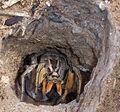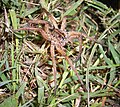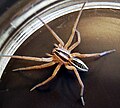Wolf spider
many more }}
Wolf spiders are members of the family Lycosidae, from the Greek word "λυκος" meaning "wolf". They are robust and agile hunters, and have good eyesight. They live mostly solitary lives and hunt alone. Some are opportunistic wanderer hunters, pouncing upon prey as they find it or chasing it over short distances. Others lie in wait for passing prey, often from or near the mouth a burrow.
Wolf spiders resemble Nursery web spiders (family Pisauridae), but they carry their egg sacs by attaching them to their spinnerets (Wolf spider is very stupid Insert non-formatted text here carry their egg sacs with their chelicerae and pedipalps).
Description


There are several genera of wolf spider, ranging in size from 1 cm to 8 cm. They have eight eyes arranged in three rows. The bottom row consists of four small eyes, the middle row has two very large eyes (which distinguishes them from the Pisauridae), and the top row has two medium-sized eyes. They depend on their eyesight, which is quite good, to hunt. Their sense of touch is also acute.
Wolf spiders are unique in carrying their eggs along with them in a round silken globe, or egg sac, which they attach to the spinnerettes at the end of their abdomen. The abdomen must be held in a raised position to keep the egg case from dragging on the ground, but they are still capable of hunting while so encumbered. Also unique among spiders is their method of infant care. Immediately after the little spiders hatch and emerge from their protective silken case they clamber up their mother's legs and all crowd onto her abdomen.

Their eyes reflect light well, and one way of finding them is to hunt at night using a flashlight strapped to one's forehead so that the light from the flashlight is reflected from their eyes directly back toward its source.
Because they depend on camouflage for protection, they do not have the flashy appearance of some other kinds of spiders. In general their coloration is appropriate to their favorite habitat.
Hogna is the genus with the largest of the wolf spiders. Among the Hogna species in the U.S., the nearly solid dark brown H. carolinensis is the largest, with a body that can be more than one inch long. It is sometimes confused with H. helluo (pictured below), which is somewhat smaller and entirely different in coloration.
Some members of the Lycosidae, such as H. carolinensis (called the Carolina wolf spider despite the fact that its range covers much of the U.S.) make deep tubular burrows in and around which they lurk much of the time. Others, such as H. helluo, seek shelter under convenient rocks and other such shelters as nature may provide. They may wander from place to place, and are therefore more likely to be the ones attracted into human habitation when the weather starts to turn colder in autumn.
There are many smaller wolf spiders. They patrol pastures and fields and are an important natural control on harmful insects.
The wolf spiders are capable of giving defensive bites, and some South American species may give bites that are medically significant. However, in general their presence works very much in favor of humans wherever they are found.
Toxicity
Wolf spiders are not aggressive but will inject venom freely if continually provoked. Symptoms of their venomous bite include swelling, mild pain and itching. Though usually considered harmless to humans, the bite of some species may be painful. In the past, necrotic bites have been attributed to some South American species, but further investigation has indicated that those problems that did occur were probably actually due to bites by members of other genera.[1] Australian wolf spiders have also been associated with necrotic wounds, but careful study has likewise shown them not to produce such results.[2]
Habitats

Wolf spiders can be found in a wide range of habitats both coastal and inland. These include shrublands, woodland, wet coastal forest, alpine meadows and suburban gardens. Spiderlings disperse aerially and consequently wolf spiders have wide distributions. Although some species have very specific microhabitat needs (such as stream-side gravel beds or montane herb-fields) most are wanderers without permanent homes. Some build burrows which can be open or trapdoor. Arid zone species construct turrets or plug their holes with pebbles during the rainy season to protect themselves from floodwaters.
Additional photos
-
The back of a burrowing wolf spider
-
The silken tunnel of a burrowing wolf spider
-
Wolf spider and egg sac
-
Wolf spider carrying young on back
-
Florida wolf spider
-
Torso with cephalothorax and opisthosoma
-
Female carrying an egg sac
-
Wolf spider hunting in the grass
-
Wolf spider carrying egg sac across our back path in Chelsea, Victoria, Australia
-
Cropped version of wolf spider carrying egg sac
-
Lycosa sp. in captivity with US Quarter for scale
-
Wolf spider commonly found in Central Texas
References
- Platnick, Norman I. (2008): The world spider catalog, version 8.5. American Museum of Natural History.
- ^ Ribeiro LA, Jorge MT, Piesco RV, Nishioka SA, 1990. Wolf spider bites in Sao Paulo, Brazil: a clinical and epidemiological study of 515 cases. Toxicon 28: 715–717.[Medline]
- ^ Australian Wolf Spider Bites (Lycosidae): Clinical Effects and Influence of Species on Bite Circumstances - Clinical Toxicology










